Key takeaways:
- Design systems enhance collaboration and consistency, serving as a shared toolkit that empowers teams to streamline workflows and avoid reinventing elements.
- Establishing clear design principles rooted in user empathy, simplicity, and functionality is essential for guiding decision-making and creating cohesive user experiences.
- Implementing a feedback loop and integrating flexibility in design fosters continuous improvement and innovation, making it crucial to adapt while maintaining brand consistency.

Understanding Design Systems
As I delved into the world of design systems, it hit me just how crucial they are for ensuring visual and functional consistency across projects. I remember the first time I tried to implement a design system; I felt overwhelmed by the thought of creating a cohesive experience out of so many moving parts. What I learned was that a design system isn’t just about aesthetics—it’s about creating a shared language that fosters collaboration among designers and developers.
There was a moment when I realized how empowering a design system could be. I was in the middle of a project with tight deadlines, and having a defined set of components allowed us to move forward confidently without second-guessing our choices. Imagine having a toolkit that not only streamlines your workflow but also infuses a sense of unity within the team; that’s the magic of a well-structured design system.
But what, really, makes a design system effective? In my experience, it’s that seamless blend between principles, guidelines, and concrete components. The emotional lift I felt when I saw team members referencing our design library instead of reinventing the wheel was incredible. It reinforced the idea that a design system can transform chaos into clarity, and who wouldn’t want that?

Identifying the Need for Consistency
Identifying the need for consistency in design can often be a lightbulb moment. Reflecting back on a project I was involved in, I noticed how varying styles across pages clouded the user’s experience. It was an overwhelming mix of colors, fonts, and button styles that didn’t speak to each other, making our product feel disjointed. Once I recognized that we were straying from a unified look, it became clear—consistency wasn’t merely a nice-to-have; it was essential for clarity and user satisfaction.
Here are some indicators that highlight the necessity for consistency in design systems:
- User Confusion: When users struggle to navigate due to differing visual cues, it becomes imperative to standardize elements for clarity.
- Team Frustration: If designers are constantly debating color choices or typographical decisions, it signals a need for a comprehensive guideline.
- Brand Dilution: Inconsistent branding across different platforms weakens brand identity, making consistency paramount for recognition.
- Development Slowdowns: If developers are repeatedly unsure which component to use, it highlights the absence of a centralized resource.
- Feedback Overload: Consistent negative feedback regarding UI can often stem from visual inconsistency, underscoring the need for a cohesive approach.
Recognizing these signs can be the first step toward building a robust design system that elevates both user experience and team dynamics. Each time I have taken steps towards consistency, I’ve seen the transformation in the environment—it’s more focused, engaged, and purposeful.

Establishing Design Principles
Establishing design principles is a foundational step that brings clarity and direction to any design system. From my experience, it’s not just about laying down rules—it’s about cultivating a mindset within the team. I remember the first time we sat down as a group to define our design principles; it was eye-opening to see how our individual experiences shaped our collective vision. We recognized the significance of user empathy, aesthetic harmony, and functionality, crafting principles that wouldn’t just guide our decisions but also resonate emotionally with users.
The emotional connection I felt during this process was profound. We could visualize how these principles would guide our designs, ensuring that every button, every font, and every color choice had a reason behind it. For instance, when we listed “simplicity” as a core principle, it wasn’t just an abstract idea to us; it reminded us of the confusion our users faced before. This realization made it clear: every design element needed to align with our principles to create a seamless experience.
To effectively establish design principles, it can be beneficial to compare potential principles against design goals. This creates a clear pathway for what each principle is intended to accomplish. Here’s a simple comparison that illustrates this:
| Design Principle | Design Goal |
|---|---|
| User Empathy | Enhance user satisfaction by understanding needs |
| Simplicity | Reduce cognitive load for easier navigation |
| Aesthetic Harmony | Create a visually appealing and cohesive experience |
| Accessibility | Ensure inclusivity for all users |
Establishing these principles has a ripple effect throughout the design process, transforming not only the final product but also how teams collaborate and make decisions together. I can say from my own experience that when the principles are embedded in the mindset of the design team, decision-making becomes instinctual—almost second nature.

Creating a Comprehensive Documentation
Creating comprehensive documentation is a crucial step in reinforcing consistency within a design system. Reflecting on a project where I meticulously documented each component, I realized that it wasn’t merely about record-keeping. It transformed into a living guide that educated new team members while serving as a reference for seasoned designers. I can’t stress enough how invaluable it is to have a single source of truth—when everything is documented, it minimizes misunderstandings and keeps everyone aligned.
The documentation process can also bring up revealing discussions within the team. I remember a brainstorming session where we dissected existing components, each voice adding layers of depth to the conversation. I often found myself asking, “How can we make this clearer?” This question ignited remarkable insights and stories from team members about their experiences with similar elements. It reinforced the idea that documentation isn’t just a static artifact; it’s an opportunity for collaboration and growth, helping us mesh our unique perspectives into a cohesive narrative.
In my experience, pairing visual examples with written guidelines is the secret sauce for effective documentation. When I annotated design patterns with screenshots and real-use cases, it illuminated the rationale behind each decision. I can recall a team member saying how a visual cue immediately clarified their understanding of a design element’s purpose. It’s moments like these that highlight the power of comprehensive documentation—making every detail more approachable and genuinely empowering each designer to contribute confidently.

Implementing a Feedback Loop
Implementing a feedback loop is essential for continuous improvement in a design system. I remember introducing regular check-ins to capture input from team members about ongoing projects. It felt liberating to create an environment where everyone could voice their thoughts, fostering a culture of openness. This not only strengthened collaboration but also revealed insights that often went unnoticed in solo work.
What surprised me was the impact of anonymous feedback. During one particularly revealing feedback session, team members shared their thoughts without the pressure of identification. The ideas that emerged were transformative. It made me realize how crucial it is to ensure everyone feels safe to speak up. Sometimes, the most valuable insights come from those who may feel hesitant to contribute in a more public setting.
Reflecting on my experiences, I’ve learned that acting on feedback swiftly is key. I recall a time when we received a suggestion to adjust a color palette based on user testing. Instead of deliberating endlessly, we made the change and tested again. The positive response from users was immediate and undeniable. It reminded me that a responsive feedback loop not only enhances design but also cultivates trust among team members, showing them that their voices truly matter.

Integrating Flexibility in Design
Integrating flexibility in design is crucial for adapting to evolving needs while maintaining consistency. I’ve often found that instead of rigid guidelines, adopting flexible frameworks allows designers to explore creativity while still keeping within established parameters. For instance, during a recent project, we faced a client who wanted to push boundaries with our color schemes. Instead of shutting down their ideas, I encouraged the team to experiment within our palette rules, leading to innovative solutions we hadn’t initially considered.
There was a time when I witnessed firsthand the impact of flexible design principles. A developer on my team expressed frustration about the limitations of our existing component library. This sparked a brainstorming session where we re-evaluated our approach. The result? We developed a modular system that empowered designers to mix and match elements while ensuring brand consistency. It made me realize that flexibility doesn’t mean chaos; instead, it encourages collaboration and experimentation that can significantly enhance creativity.
Have you ever felt like a design system was stifling your creativity? I certainly have, and I learned that allowing room for flexibility can lead to unexpected breakthroughs. By fostering an environment where team members felt comfortable suggesting new approaches, we reinvented aspects of our design language. Reflecting on those discussions revealed that embracing flexibility isn’t just a method—it’s a mindset shift that enables true innovation while maintaining a cohesive design identity.

Measuring Success and Iterating
Measuring success in a design system isn’t just about metrics; it’s also about how the team feels about their work and the process. One initiative I implemented was to align our success criteria with team sentiment. I remember asking everyone, “What makes you feel proud of the work we do?” The responses varied but highlighted a shared appreciation for craftsmanship and user satisfaction. This emotional connection became a guiding force for our iterations, ensuring that we didn’t overlook the human aspect of design.
As I set about analyzing project outcomes, I learned that quantifying success through user feedback and engagement metrics was invaluable. After launching a new component, I initiated follow-up surveys and usability tests to measure its effectiveness. In one instance, user feedback revealed that a feature we believed was intuitive was actually causing confusion. It was a tough pill to swallow, but rather than getting defensive, we regrouped, restructured the component, and relaunched. The improved metrics were satisfying, but what really mattered was how our users felt more engaged and understood, which ultimately fostered a stronger connection with our design system.
Iteration became less daunting when I embraced it as an opportunity rather than a chore. I vividly recall a time when we were revising our guidelines, and I posed the question to my team: “How can we ensure we’re all learning and growing through this process?” The collaborative discussion we had shifted my perspective—each iteration was an evolution, meticulously sculpted by our collective insights. It was an exhilarating realization that measuring success isn’t only about the final product; it’s about the journey and the constant growth that comes from reflecting, adapting, and celebrating both small victories and challenges along the way.














